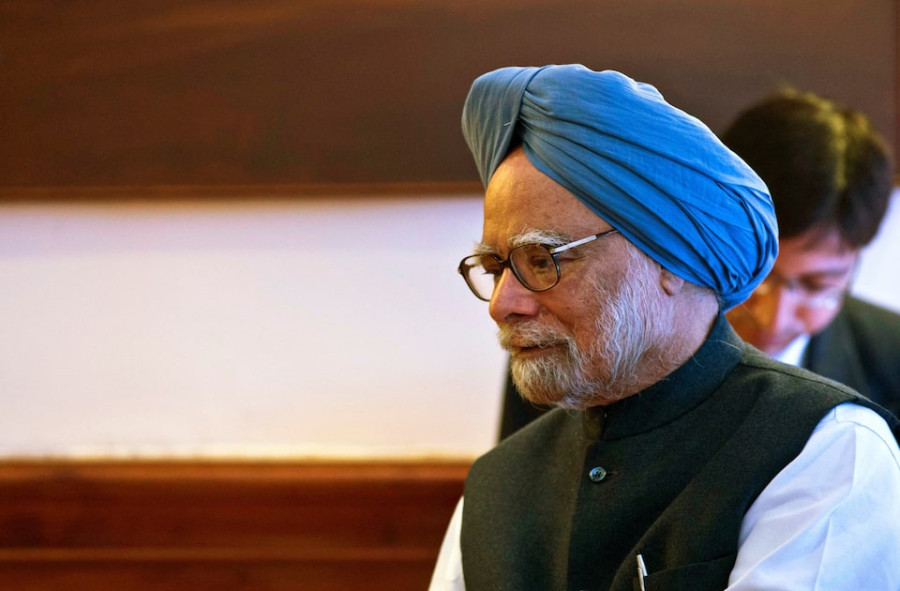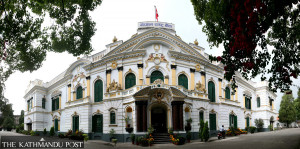Columns
The power of economic reform
Nepali economy can learn a lot from the reform and growth of the Indian economy.
Achyut Wagle
Former Indian Prime Minister Manmohan Singh, known as the ‘reforms man’, died last Thursday. He was a key architect of India’s economic liberalisation as finance minister from 1991 to 1996. Indian and global media have flooded their stories with his major policy reforms that rescued the Indian economy from the brink of collapse in 1991, lifted millions from abject poverty, and transformed India into a global economic powerhouse, which is aiming to be the third-largest economy within the next few years. According to The BBC, Singh changed the country’s growth trajectory during his two consecutive terms as prime minister between 2004 and 2014.
Prime Minister Narendra Modi was short of acknowledging him as the quintessential economic reformer in Indian history. Nonetheless, he paid a generous tribute to Singh, who belonged to the opposition Indian National Congress party.
India’s economic growth in the post-independence era of 1950-1990 was constricted to an average annual rate of 4 percent. It was often satirically termed the socialist rate of growth, or the Bharatiya rate of growth, or even the Hindu rate of growth. Some competitive growth statistics only confirm that. For example, the average per capita gross domestic product (GDP per capita) of China ($90) and India ($83) was almost similar in 1960. It didn’t differ significantly until 1990, when China’s GDP per capita was $318, against India’s $304. China surpassed the $1,000 mark in 2000, but India had to wait another decade to meet the same milestone. China’s national GDP grew from $60 billion in 1960 to $17.81 trillion in 2023, while India, with $37 billion in 1960, could only rise to $3.55 trillion in 2023.
Power of reform
Several bold reforms were initiated in 1991, such as the freedom to enterprise from the infamous “Licence Raj”, the devaluation of the Indian currency against the dollar, the liberalisation of interest rates, making the capital accounts (partially) convertible and ensuring autonomy of the regulatory authorities in financial sectors, among others. These were critical in unleashing the growth potential, and successive governments, even from different ideological orientations, continued this momentum of comprehensive structural reforms. Consequently, India is now pursuing a lofty dream of making the size of its economy equal to that of China by 2050.
Some extrapolations have projected the Chinese economy to be the largest, worth at least $42 trillion, the Unites States’ economy to be the second largest, worth $37 trillion, and the Indian economy to be the third largest, worth $23 trillion. The current political leadership hopes to double that size. These aspirations are undoubtedly contingent on the continuation and expansion of these reforms.
The answer to why India, Nepal and other countries lagged behind China in economic prosperity remains in the power and direction of economic reform.
The growth of these countries began to unfold late, which delayed their reform. China started its market reform, mainly opening the door for foreign investment and allowing individual entrepreneurs to start businesses in 1980, a decade before India. Therefore, China started to reap the benefits from the early 90s, while India had to wait another decade. The difference in the size of the national GDP of these two countries reflects the missed opportunity cost of India’s late start.
The impressive growth saga of four Asian tigers—Hong Kong, Taiwan, Singapore and South Korea—from the 1970s to 1990s was also driven by the private sector and openness-oriented reforms. Rapid industrialisation, adoption of state-of-the-art technology and exports helped them steadily retain an average 7.5 percent economic growth rate for three decades, eventually listing them in the ‘richest countries in the world’ club. After the turn of the century, Malaysia, Vietnam and Thailand followed suit. But the magic fulcrum for this growth is unequivocal reform. For poor and developing countries, including China and India, the unfortunate part was that the governments failed to underscore the importance of legal and institutional reforms and emulate their success stories during those decades.
Nepal and reform
Economic reforms in India and Nepal started almost simultaneously—at the beginning of the 1990s. The Indian reform process, by and large, did not falter. But Nepal vacillated within years. In 1995, the communist government came into power with a crude socialist hangover, making populism and pork-barrel distribution its policy mainstay. The country then reeled under a decade-long insurgency (1996-2006), only to bring another radical Maoist ideology to the political mainstream. The obvious consequence was a reversal of reform policies like ‘reconsidering’ the privatisation of loss-making public enterprises, adopting more distributive policies without ascertaining fund sources and creating a stronger narrative of a socialist-oriented economy.
In some areas, such as private investment and banking, the economic and fiscal reform delivered impressive results. At present, the Nepali economy cannot be imagined without duly recognising private investment’s impact on the growth and expansion of sectors like hydropower, banking and insurance, aviation, transport, tourism, telecommunications and information technology, education, health services, pharmaceuticals and retail markets.
Despite these tangible reform outcomes, the Nepali state is still hesitant to undertake comprehensive structural reform. Legal reform at the federal level is too tardy, piecemeal and fragmented. The institutional efficiency of the bureaucracy has constantly remained suboptimal, warranting a different strategy from hiring and training to deputation. The model of policy reform for financial management and economic development at the subnational level is yet to be charted out.
As the developing world now considers a ‘Second Generation of Economic Reforms’, with a lag of at least two decades, the foundations laid by Manmohan Singh in India, Ram Sharan Mahat and team in Nepal, and Deng Xiaoping in China through what may be called the first generation of reform remains valuable. Needless to say, the reform and growth of the Indian economy and its lessons are always critical to the Nepali economy as they are inseparably intertwined.
A true tribute to Manmohan Singh would be to keep the reform momentum he courageously embarked upon alive. Two recent books, Backstage: The Story Behind India's High Growth Years by Montek Singh Ahluwalia and Portraits of Power: Half a Century of Being at Ringside by NK Singh, two Sherpas in senior Singh’s reform journey, provide a valuable reference to the context and challenges of economic reform in the context of Nepal and the South Asian region as a whole.




 16.12°C Kathmandu
16.12°C Kathmandu















